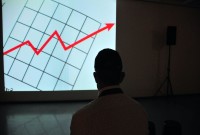- Home
- Business Processes
- Industry Knowledge
- Aerospace Industry
- Automotive Industry
- Banking Domain
- BFSI Industry
- Consumer/ FMCG Industry
- Chemicals Industry
- Engineering & Construction
- Energy Industry
- Education Domain
- Finance Domain
- Hospitality Domain
- Healthcare Industry
- Insurance Domain
- Retail Industry
- Travel and Tourism Domain
- Telecom Industry
- Leadership Skills
- eLearning
- Home
- Leadership Skills
- Leadership Theories
- Contingency Theories in Action
Contingency Theories in Action
Contingency theory suggests matching the best leader to a specific situation based on situational factors and the leadership style. The practical application of theory can be done in various ways. The workplace example is to determine the best candidate for a given set of requirements using the LPC score. Applying the model to determine a leader's ability to adapt in the scenario of a new project etc..
Recap of Learnings from Contingency Theory:
Fielder’s contingency theory matches the leader to the situations by using the Least Preferred Co-Worker (LPC) model. A leader can perform effectively in certain roles and exhibit weakness in different situations based on three variables defined in the earlier article which predicts the favorability of the situation, while the leader’s LPC score determines the ability to function in the required task.
One can make use of the contingency theory to determine the best candidate for a given set of job requirements for effectiveness of a person in that role as by measuring a leader’s LPC score and the three situational variables, one can predict whether the leader is going to be effective in a particular setting. By assessing these three situational variables, one can place any organizational context in one of the eight categories represented in previous article. Once the nature of the situation is determined, the fit between the leader’s style and the situation can be evaluated.
Key Strengths of Contingency Theory:
1. Contingency theory is grounded in research as many researchers have tested it and found it to be a valid and reliable approach to explaining how effective leadership can be achieved.
2. This theory considers the impact of situations on leaders and focuses on the relationship between the leader’s style and the demands of various situations.
3. Third, contingency theory has predictive power and based on conclusions from LPC scale and understanding the context of the workplace situation one can determine the probability of success for a given person in a given situation.
4. From an organizational perspective it supports identification of optimal roles based on individual leadership styles and placing leaders in charge of situations that are ideal for their leadership style.
Practical Applications of the Theory:
Contingency theory has many applications in the organizational world:
1. Can be used to assess the effectiveness of an individual in a particular role and look at the reasons for one’s effectiveness or ineffectiveness.
2. Can be used to predict whether a person who has worked well in one position in an organization will be equally effective in another position having different situational variables when compared to the existing position based on the contingencies that make one’s style effective.
3. Can help in implementing changes in the roles and responsibilities that management might need to make to bring effectiveness to the role of the person leading the same.
Fiedler’s theory does not hold that leaders can adapt their styles to different situations as according to him personality is relatively stable. According to this model improving effectiveness involves changing the situation to fit the leader sometimes also referred to as “job engineering”.
As now we have more understanding of leadership and its challenges in the 21st century organizational context, contingency model might not be the best leadership model to use in most situations, but still can be a powerful tool to analyze a particular situation to determine whether to focus on tasks or relationships. This model sometimes can give an inaccurate picture of your leadership style as it relies heavily on the LPC scale, which has been questioned for its face validity and workability. Further this model does not fully explain how organizations can use the results of this theory in situational engineering and hence we recommend taking a cautious approach and using your own judgment to analyze the situation from all angles.
Related Links
You May Also Like
-
Communication has as its central objective the transmission of meaning. The process of communication is successful only when the receiver understands an idea as the sender intended it. How does a message or an idea travel from one person to another? To transmit our message, we engage in a sensitive and complex process of communication, with different elements like sender, message, channels, receiver, noise, and feedback.
-
The skills approach to leadership suggests that certain skills are important for effective leadership. Skills are what leaders can learn and develop, whereas traits are innate characteristics. The main skills needed for leadership, according to one such theory, are technical, human, and conceptual.
-
According to the three-skill approach of Katz, the individual's leadership abilities vary depending on where leaders are in a management hierarchy. The practical implication of skills approach to leadership is that leaders can improve their capabilities in leadership skills through training and experience.
-
The ten most important qualities that define a good leader are self-awareness, interpersonal and communication skills, ethical values, organizational consciousness, self-confidence, adaptability and flexibility, imagination and creativity, focus & result-orientation, continuous self-development and accountability and ownership for his actions. These ten qualities of leadership every good leader should possess to a certain extent and must continually strive to develop them.
-
Management theories are the recommended management strategies that enable us to better understand and approach management. Many management frameworks and guidelines were developed during the last four decades.
-
Charismatic leadership is a trait-based leadership theory where the leaders act as visionary driven by their convictions and motivate their followers to work towards common vision using their charm and persuasiveness. These charismatic leaders act as role models and exhibit extraordinary characteristics that inspire devotion and motivation in followers to persuade change. Leaders are able to cultivate a profound sense of trust with the group of followers.
-
Jung first introduced his personality theory and explained that all humans have a natural impulse to relate meaningfully to the world through productive work and people through significant relationships. He used four psychological functions - thinking and feeling (rational functions) and sensation and intuition (irrational functions). He also used introversion and extraversion and its impact on appropriate leader behaviors.
-
The four theory of leadership was formulated after studying hundreds of leaders and the model includes four basic dimensions of effective leadership - support; interaction; facilitation; goal emphasis, and work facilitation. This model was tested as a predictor of an organization's effectiveness.
-
The development of teams is an ongoing process because the composition of the team may keep on changing. The new members may join and the old members may leave the team. The team members pass through several stages for the development of the team and there has been a lot of research to identify these stages. In this article, we discuss the common theories of team development.
-
Action Centered Leadership is a model developed by John Adair and focuses on the three responsibilities of a leader which are achieving the task, managing the team, and managing individuals. All these action elements are mutually dependent and important for any leader.
Explore Our Free Training Articles or
Sign Up to Start With Our eLearning Courses

About Us
Learning
© 2023 TechnoFunc, All Rights Reserved










